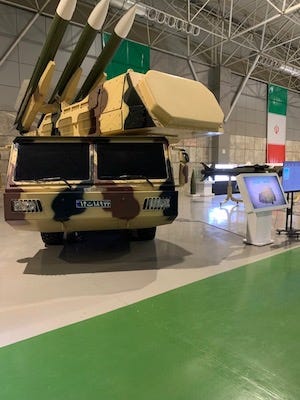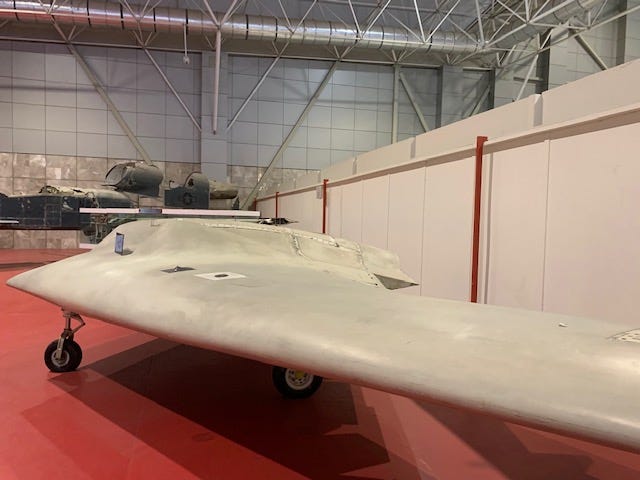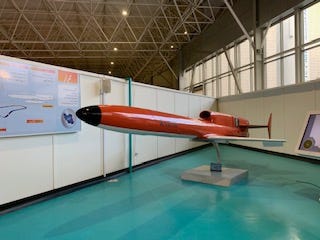That Chinese Balloon Looks Different from Tehran
That Chinese Balloon Looks Different from Tehran
Remember Iran's shootdowns of US spy drones under Obama and Trump?

Tehran, 1/6/23
Using a spotty Iranian internet connection, I have been casting a few bemused cyber-glances homeward as Americans panic over a Chinese spy balloon. Republicans call Biden weak because he let the balloon meander over America for a couple of days before terminating it off the coast of South Carolina. Democrats say Biden did well to down it into the ocean, capture its spy tech payload, and avoid endangering civilians.
Here in Tehran, people are, as usual, simultaneously amused and appalled at America’s unique proprietary blend of arrogance and stupidity. How can the US feign outrage over China’s violation of its airspace with spy equipment, when the world’s worst violator of other nations’ sovereignty in general, and their airspace in particular, is that very same United States of America?
And since when is a balloon a national security threat? Spy satellites have been reading license plates since the 1960s—and peering through roofs, examining insect anatomy, and zooming in to people’s pores since the 1980s. Yet it seems that Bubba and Mrs. Bubba have only now discovered that somebody overhead is watching them guzzle beer in the back yard.
Shooting down a slow-drifting balloon at 60,000 feet — especially when the nation conducting the shootdown spends more money on its military than all the other major powers combined — is hardly a remarkable feat. But when Iran, on June 20, 2019, brought down a United States RQ-4A Global Hawk BAMS-D surveillance drone flying at about that same altitude, the world in general, and the US military in particular, was not just impressed, but stunned.
I recently visited the Tehran Aerospace Exhibition Center with a group of American journalists, including my False Flag Weekly News colleague J. Michael Springmann, who took the photos posted here.
That top-of-the-line US surveillance drone cost more than 200 million dollars. It was one of only four ever built, and one of only two that were operational. Boasting five different anti-radar systems, including shaping, engine coating, and exhaust cooling, the 40-meter-wingspan monstrosity, if even picked up by radar, barely registered. It could spoof ground systems and pass as a civilian passenger airliner, or imitate a flock of birds.
The Iranians knocked it down in one shot, using a 100% indigenous air defense system. What makes the feat even more impressive is that the drone was being tailed by a P8 Poseidon with at least a few dozen US servicemen on board. Iran’s ability to distinguish between the two planes and down the drone while leaving the manned plane unharmed showcased an impressive blend of technical proficiency and morality.

Despite Iran’s humanitarian avoidance of harming the P8 and its passengers, Trump came close to ordering an attack on Iran that would have killed around 50 people, or so he said when explaining why he had called it off. Iranian analysts suggest that Trump knows that Iran’s capacity for proportionate retaliation—every US base and ship in the region is in the crosshairs of Iran’s missiles—may have played a role.
The fact that Iran felt confident enough to down the drone in the first place greatly impressed a Chinese official, who expressed his nation’s astonished admiration to Iranian officials, according to Iranian analyst Dr. Khosh Chesm: “We respect you more after you shot this drone down with the first shot. We never expected Iran could do that,” the Chinese official told Iranian counterparts.
Indeed, Iran is the only nation on earth that has repeatedly downed or otherwise captured US surveillance drones. Even China, which has the technical proficiency to protect its airspace from anyone, threatens and if necessary fires on all intruders except American ones, who are routinely issued empty warnings yet allowed to go about their illegal, sovereign-airspace-violating business. For now, anyway.*
The 200 million dollar RQ4A is the crown jewel in Iran’s collection of downed drones. But it’s only one of many. Another that made the news is an RQ-170 Sentinel that Iran electronically hijacked and landed in 2011. Then-US-president Barack Obama famously begged the Iranians to give it back, to no avail.

According to Dr. Chesm, Iran has downed or captured at least one of all major US drones, spurring a reverse engineering program that has made Iran a leader in drone technology. Even Iran’s mid-level drones, whose capabilities are far below the top-of-the-line models, have been playing a significant role in the war in Ukraine, as evidenced by panicked US indignation and recent failed attacks on Iranian drone factories. Dr. Chesm told me that last week (as I was preparing to leave for Iran) three Israeli quadcopters, presumably flying with US blessings, attacked a drone factory in Isfahan. Two were intercepted by Iranian electronic defenses, “hit the suicide button” and exploded themselves, while the third was captured.
Iran views its drone/counterdrone activities as efforts to defend itself from an ongoing US hybrid war. In my next report from Tehran I will discuss Iranian views of that hybrid war.
*China’s reluctance to shoot down airspace violators stems from its extreme caution and willingness to go to almost any length to avoid risking war with the US. But in the wake of reports that the US may have sparked the 2018 chicken flu and 2019 bird flu epidemics by spraying farms with pathogens (precursors to the likely fall 2019 bio-attack on Wuhan?) followed by recent US efforts to arm Taiwan with some of the world’s most powerful weapons systems, the odds that China will continue to let the US systematically violate its airspace with military craft are declining precipitously. The balloon shootdown and ensuing US media circus may also help convince the Chinese to emulate Iran and start protecting itself.




Comments
Post a Comment